Structural Rearrangements in Water Viewed Through Two- Dimensional Infrared Spectroscopy
Author(s)
Roberts, Sean Thomas; Ramasesha, Krupa; Tokmakoff, Andrei
Downloadwater review - total manuscript revised.pdf (5.910Mb)
PUBLISHER_POLICY
Publisher Policy
Article is made available in accordance with the publisher's policy and may be subject to US copyright law. Please refer to the publisher's site for terms of use.
Terms of use
Metadata
Show full item recordAbstract
Compared with other molecular liquids, water is highly structured because of its ability to form up to four hydrogen bonds, resulting in a tetrahedral network of molecules. However, this underlying intermolecular structure is constantly in motion, exhibiting large fluctuations and reorganizations on time scales from femtoseconds to picoseconds. These motions allow water to play a key role in a number of chemical and biological processes. By exploiting the fact that the OH stretching frequency of dilute HOD in liquid D2O is highly dependent upon the configuration of the neighbor nearest to the proton, researchers have been able to track water’s time-dependent structure using two-dimensional infrared (2D IR) spectroscopy, which tags molecules at an initial frequency and then watches as that frequency evolves with respect to time. Recent advances in molecular dynamics simulation techniques allow for the calculation of 2D IR spectra, providing an atomistic interpretation tool of 2D IR spectra in terms of the underlying dynamics of the liquid. In this Account, we review recent ultrafast 2D IR studies at MIT that provide new information on the mechanism of hydrogen-bond rearrangements in liquid water.
The 2D IR spectra of the OH stretching vibration of HOD in D2O appear highly asymmetric. In the frequency range indicative of hydrogen-bonded molecules (<3300 cm−1), the 2D spectra remain fairly compact. By contrast, in the frequency range in which molecules having weak or broken hydrogen bonds absorb (>3500 cm−1), the 2D spectra broaden over a time scale of 60 fs, consistent with librations (hindered rotations) of water molecules. This broadening indicates that molecules forming weak or broken hydrogen bonds are unstable and reorient rapidly to return to a hydrogen-bonded configuration. These conclusions are supported by the results of molecular dynamics simulations, which suggest that water molecules undergo a large-angle reorientation during the course of hydrogen-bond exchange. The transition state for hydrogen-bond rearrangements is found to resemble a bifurcated hydrogen bond. Roughly half of the hydrogen-bond exchange events in the simulation are found to involve the insertion of a water molecule across a hydrogen bond, suggesting that hydrogen-bond exchange in water involves the correlated motion of water molecules as far away as the second solvation shell.
The combination of ultrafast 2D IR spectroscopy with simulation-based modeling is leading to self-consistent descriptions of the underlying dynamics in liquid water. Moreover, these results also demonstrate a more general, unique characteristic of the spectroscopy: if a spectral signature of the transition state exists, then 2D IR can effectively serve as a transition-state spectroscopy.
Date issued
2009-09Department
Massachusetts Institute of Technology. Department of ChemistryJournal
Accounts of Chemical Research
Publisher
American Chemical Society
Citation
Roberts, Sean T., Krupa Ramasesha, and Andrei Tokmakoff. “Structural Rearrangements in Water Viewed Through Two-Dimensional Infrared Spectroscopy.” Accounts of Chemical Research 42.9 (2009): 1239–1249.
Version: Author's final manuscript
ISSN
0001-4842
1520-4898